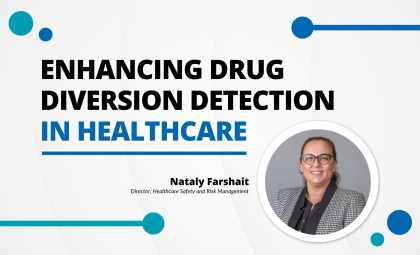Enhancing Drug Diversion Detection in Healthcare

Drug diversion in healthcare is a safety concern not often talked about. Diversion essentially refers to theft of medications, either for personal use or for trafficking. Bringing risks like this one to light is a core component of HIROC, as is scaling knowledge to help Subscribers across Canada create the safest healthcare system.
This year HIROC hosted the designers of a new Pan-Canadian Diversion Risk Assessment Tool on Talk with HIROC – our exclusive LinkedIn Live show. The tool was developed by North York General Hospital (NYGH), the Institute for Safe Medication Practices (ISMP Canada), and the University of Toronto.
Michael Hamilton (ISMP Canada), Mark Fan (NYGH), and Patricia Trbovich (U of T) led an informative discussion to raise awareness of this risk, the tool, and appropriate mitigation strategies.
In my role as a Director of Healthcare Safety and Risk Management at HIROC, and as a lifelong advocate for patient and healthcare worker safety, I believe that initiatives like this are a critical intersection between patient safety and staff safety. And I feel strongly that through leveraging the tool, our Subscribers will gain a greater understanding of this risk and its implications across the system.
A Background on Drug Diversion and Human Factors
In the past, the healthcare sector’s response to patient safety incidents was to regard humans as the root cause of issues and hold them responsible for mistakes. Patient safety incidents would be attributed to human error, rather than focusing on identifying and addressing the underlying system issues.
Since then, human factor research moved system thinking away from a culture of blame, to asking questions like: “How did the system fail to detect or avert diversion?”
During the live stream, the panel explained how initial research into drug diversion saw parallels between this old way of thinking – seeing it as person problem rather than a system problem. They wanted to reframe the problem and look at how our systems failed to avert and detect diversion.
The resulting tool establishes a deep understanding of how hospital medication-use processes are vulnerable. It offers effective interventions for safeguarding against diversion, through the lens of system susceptibility.
The Connect Between Diversion Risks and Wellness
We know anyone experiencing high levels of stress and burnout are more likely to engage in an ineffective coping mechanism – this applies to healthcare providers. What’s critical is early identification of healthcare workers who require support, and employing a variety of evidence-based strategies, such as mindfulness-based therapies for supporting wellness.
The issue of burnout was heightened by the pandemic and its impact on healthcare providers. According to recent literature, those who were directly involved in COVID-19 patient care are at increased risk of experiencing burnout. Moreover, the pandemic had a notable consequence on the work environment, including stress related to responding to the virus, and working through persistent staffing challenges.
Again, it’s clear that the drug diversion tool is needed now more than ever.
HIROC Bringing Partners Together for Safety
Because of our unique role in the healthcare system, HIROC is always on the look-out to share knowledge and scale lessons learned across the sector. The HIROC community is so strong, and we are grateful for their support and engagement!
We hope Subscribers will register for the free Pan-Canadian Diversion Risk Assessment Tool by visiting ISMP Canada’s website or by emailing [email protected].
By proactively assessing risk and prioritizing the safety and well-being of healthcare workers, we can make significant strides in further improving the quality of care we provide.
We encourage all Subscribers to take advantage of the Pan-Canadian Diversion Risk Assessment Tool to identify areas of potential vulnerability and proactively prevent drug diversion.
Nataly Farshait is HIROC’s Director of Healthcare Safety and Risk Management